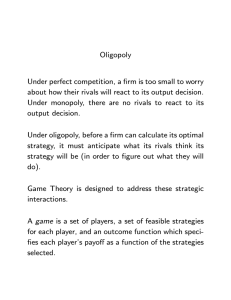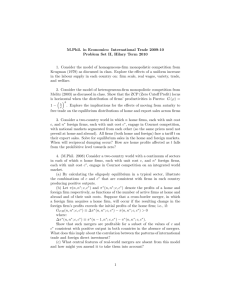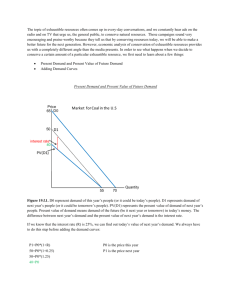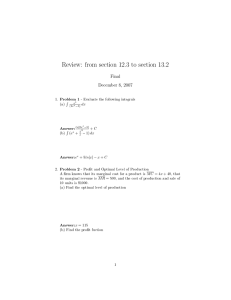Once-and-for-All Costs and Exhaustible Resource Markets Carolyn Fischer Discussion Paper 98-25
advertisement
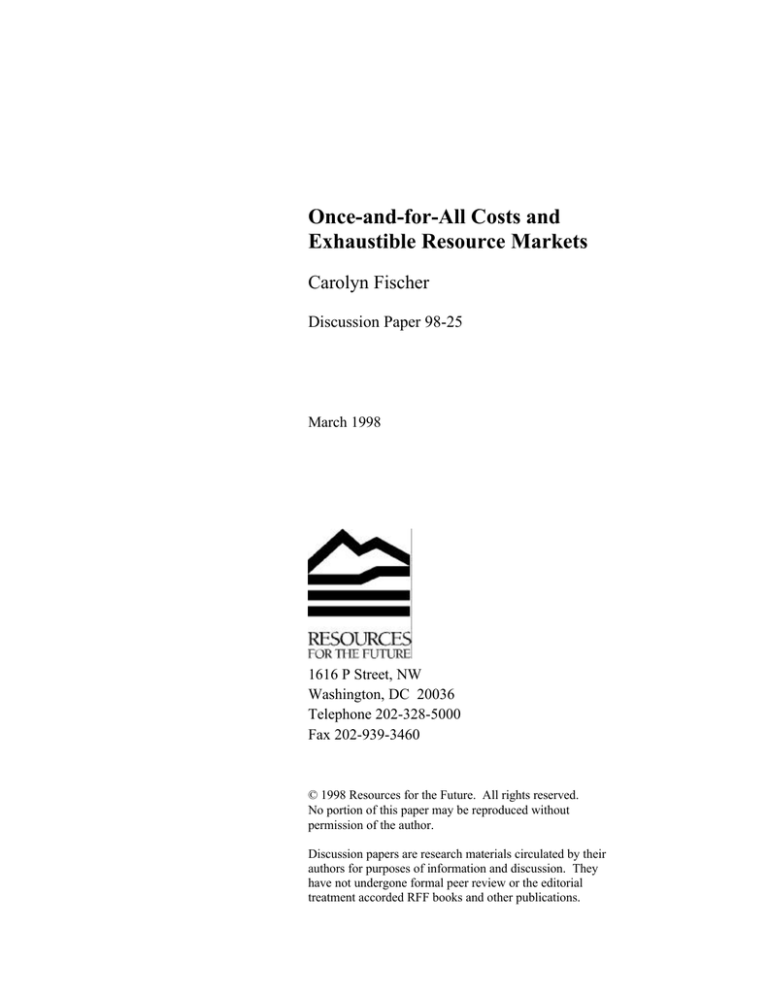
Once-and-for-All Costs and Exhaustible Resource Markets Carolyn Fischer Discussion Paper 98-25 March 1998 1616 P Street, NW Washington, DC 20036 Telephone 202-328-5000 Fax 202-939-3460 © 1998 Resources for the Future. All rights reserved. No portion of this paper may be reproduced without permission of the author. Discussion papers are research materials circulated by their authors for purposes of information and discussion. They have not undergone formal peer review or the editorial treatment accorded RFF books and other publications. Once-and-for-All Costs and Exhaustible Resource Markets1 Carolyn Fischer2 Resources for the Future March 13, 1998 Abstract This paper analyzes the impact on exhaustible resource markets of setup or shutdown costs, a sparsely analyzed category of nonconvex production technologies. This paper proves that, even under idealized circumstances for competition, a competitive equilibrium will fail to exist in the presence of setup costs, for any utility and cost functions such that a planner would exploit exhaustible resource pools sequentially. Keywords. rium. natural resources, setup costs, shutdown costs, nonconvexities, competitive equilib- JEL Classication No(s).: Q3, C62 Thanks to Steve Salant and Michael Moore, to conferees at the 1994 Journees de GREEN at the University of Laval, Quebec, and to seminar participants at the University of Michigan for helpful comments. This work has been supported nancially by Resources for the Future. 2 Resources for the Future, 1616 P St. NW, Washington, DC 20036. E-mail: scher@r.org 1 1 Introduction Once-and-for-all costs are common to exhaustible resource markets, occurring in the guise of setup costs, such as exploration, or shutdown costs, such as environmental cleanup and land reclamation. These costs represent a category of nonconvex production technologies, which often cause a competitive equilibrium to fail to exist. While such problems have been well documented in static markets, analysis is sparser for the eects of nonconvexities on dynamic markets for exhaustible resources. Much of the existing resource literature has concentrated on nonconvexities caused by U-shaped cost curves and xed ow costs (i.e., xed costs which are incurred in each period of extraction). The key problem here is that as exhaustion approaches and equilibrium prices rise, identical rms will be pushed to produce below minimum ecient scale (crawling back up the left side of the cost curve), which destroys the equilibrium. Lewis, Matthews, and Burness (1979) show the nonexistence of a competitive equilibrium in the presence of xed ow costs. Eswaran, and Lewis, and Heaps (1983), followed by Mumy (1984), Kimmel (1984), Fisher and Karp (1993), and Lozada (1996) examine the impact of economies of scale over a range of production (U-shaped cost curves). These authors have shown that such nonconvexities pose problems for existence of a competitive equilibrium, but existence may be restored (though not necessarily optimality) with a combination of free entry and exit, heterogeneous rms, backstop technologies, and uncertainty. Setup and shutdown costs, however, dier substantially from xed ow costs. While ow costs are xed costs incurred in each period of extraction; once-and-for-all costs are xed costs incurred only once for each resource pool, either before or after the utilization of that pool. This paper considers well-behaved (convex) ow costs, concentrating on the nonconvexities created by xed startup costs. Unlike the U-shaped costs case, the planner here will not want more than one rm producing at a time. Still, it is conceptually plausible that sequential production of an exhaustible resource may be compatible with competition. However, this paper shows that, even under idealized circumstances, the social optimum 1 cannot be decentralized in the presence of setup costs. In a regular static market, it is easy to see how setup costs may prevent the decentralization of the solution to the planning problem. Imagine an industry with a one-time, xed cost of production and a constant marginal cost. The social maximum requires P = MC , but at such a price, prots would be negative and no competitive rm would want to produce. The situation in exhaustible resource markets is similar, although less evident because of the dynamic nature of the problem. Assume once again that marginal costs are constant. Then, as in the static market, the social optimum dictates that no two rms should simultaneously produce, preventing the setup costs from being incurred twice. For the static market, this observation rules out the possibility of competition; however, for the resource market, this rule merely implies that rms will produce sequentially, since the exhaustible nature of the resource means no rm can produce indenitely. Furthermore, the optimal price of an exhaustible resource is above marginal cost, to account for its scarcity, so a rm taking socially optimal prices could still cover its xed costs, unlike the rm in the static case. Therefore, with several rms, competing over time rather than simultaneously, and with non-negative prots, a competitive equilibrium could conceivably function in an exhaustible resource market in the presence of once-and-for-all costs. Or could it? Hartwick, Kemp and Long (1986, henceforth HKL) showed that in the presence of setup costs the social optimum dictates sequential exploitation of the natural resource pools, and the optimal path of marginal current net benet will rise \in a saw-tooth fashion at an average rate less than the rate of interest" (p. 212). To demonstrate that a competitive equilibrium would not always exist, they utilized a two-period example with constant-elasticity utility and setup costs chosen so that last-period prots were zero. With this model they found that at the shadow prices associated with the social optimum, the rm earlier in the sequence would earn lower discounted prots than the one extracting later; therefore, both rms would want to produce last. This could not be an equilibrium, since excess demand would occur in the preceding period. But was this particular example symptomatic of a general problem? 2 The present paper analyzes the decentralization problem in a more general and conclusive fashion, proving that for any reasonable utility and cost functions, the competitive equilibrium will fail to exist. In the next section, the HKL problem will be revisited. Using a generalized form, the case with an innite number of deposits will then be examined, without and with variable costs. Analysis of the case of a nite number of deposits follows. It will show that a competitive equilibrium is infeasible whenever sequential extraction is warranted. 2 Model The problem to be examined will be that dened in HKL (with a few notational dierences). Each of N identical deposits has a stock of S units of the exhaustible resource. Above-ground storage is not an option, and no variable costs of extraction exist at this point. The only costs are once-and-for-all costs K ,3 which must be incurred to set up exploitation of the deposit but need not be paid if the deposit goes unused. Since HKL showed that once-and-for-all costs make optimal exploitation of the resource pools occur in sequence, these costs can be easily thought of as setup or shutdown costs; in either case, the cost must be incurred before exploitation of the next pool can begin. Social welfare equals the present value of the utility ows generated by the resource consumption (u(q )) net of setup costs. The social discount rate, r, is positive and constant.4 Let V represent the value of socially optimal extraction from the closing of the current deposit (at time T ) onward. Given that value, F (V ) represents the value of current extraction onward when the decision variables associated with the current deposit, T and q for t 2 t t For brevity, once-and-for-all costs may be referred to here as \setup costs." However, the analysis holds for any cost that must be incurred before exploitation of the next deposit can begin, including shutting down the previous deposit. 4 While HKL express K in terms of leisure and consider r a rate of time preference, this paper develops the problem in value terms, making the utility function analogous to social surplus and r an interest rate. 3 3 (0; T ), are optimally chosen: F (V ) = n qt max , K + 0 0 ;T Z T u(q )e, dt + V e, rt rT t 0 Z , T 0 q dt , S t o : (1) Thus, for the current deposit in the sequence, rst-order and endpoint conditions are obtained from dierentiating the bracketed term with respect to q : t u0 (q )e, rt t ,=0 8t; (2) and T : u(q )e, rT T , rV e, , q = 0: rT T (3) From these conditions, two key equations are derived: u0 (q )e, rt t = u0(q )e, rT T ; (4) which is the standard Hotelling result that the present value of marginal utility remains constant, thus dening q as a function of q , and t T u(q T ) , u0(q )q = rV; T T (5) which denes q as a function of V . To pin down T , a third equation is required, namely the constraint that the sum of the quantities extracted over time must equal the total stock of the resource available: Z q dt = S: (6) T T 0 t It will also be useful to dene the following variable: (q ) = u(q ) , u0(q )q : t t 4 t t (7) Note that () essentially represents net consumer surplus: total utility less the \price" (marginal utility) times the quantity. For any concave utility function beginning at the origin, assuming marginal utility is nite at that point, (q ) 0 and rises as q rises: t (0) = u(0) , u0(0)0 = 0; t 0(q ) = ,u00(q )q > 0: t t t Given the strict concavity of u(), (4) implies that q declines monotonically as t rises and thus is smallest at the time of shutdown (T ); therefore, (q ) declines as t rises and reaches its smallest point at shutdown. t t 3 Innite Number of Deposits 3.1 No Variable Costs Consider the case where there is an innite number of the resource pools.5 Municipal landlls are an example easy to visualize: they have limited capacity (the resource stock), another one can always be built, but it does not make sense to have more than one serving the municipality at a time, since large costs must be incurred for construction and for containment at closure. In the nite case, the likelihood of rms behaving competitively has been questioned, since the rms with the last deposits to be extracted would be ignoring potential monopoly rents. Looking at the innite case makes these criticisms irrelevant and focuses on the eect of the setup or shutdown costs. With an innite number of future landlls, the incentives for each landll are identical since the value stream of the subsequent innite landlls is always the same. In a stationary solution, F (V ) = V : the function maps V back into itself. From the rst equation, one can 5 Note that even though the number of resource pools (and therefore the total amount of the resource) is innite, the stock of each individual pool is nite. Furthermore, with setup costs, scarce factors in the economy must be employed to exploit each pool. Therefore, innite amounts will not be extracted. 5 solve for that V : = V R u(q )e, dt , K : 1 , e, T 0 rt t (8) rT Setting this stationary value of V equal to that derived from the individual endpoint condition (5), along with the rst-order condition (4) and the constraint (6), one can solve for q and T in terms of K and S . Thus, Equations (4)-(6) and (8) dene T , V , q , and q for t 2 [0; T ). What are the implications for a competitive equilibrium in this stationary case? Following the same logic presented with the static example, the rm's prots under socially optimal pricing will be examined. For this social planning problem to be decentralized to a competitive market, marginal benet pricing is required, and price-taking rms must be indierent as to when they produce. For the latter to hold, the present value of prots must be equal, regardless of the rm's position in the series. In a stationary solution, prots are constant because V is constant; therefore, the only way they will be constant in present value terms will be if they are zero. To answer the question of whether prots net of start-up costs are positive, negative, or zero under competitive (marginal benet) pricing, we must see whether Z u0 (q )q e, dt , K R 0: (9) T T t T rt t 0 t Using Equations (8) and (5), K can be represented in terms of the utility function and the main parameters, thus making the key question Z T u0 (q )q e, dt , Z T rt 0 t t u(q )e, dt + rt 0 t (1 , e, ) [u(q ) , u0(q )q ] R 0: r rT T T T (10) This equation can be rearranged as (1 , e, rT )[u(q ) , u0(q )q T T T ],r Z T (u(q ) , u0(q )q e, rt 0 t t t dt R 0: (11) Recalling the function () and its properties dened in Equation (7), one can rewrite 6 the previous equation in a simpler form and make the following statement: (1 , e, rT < (1 , e, rT ) (q ) , r T Z T (q )e, rt 0 ) (q ) , r (q ) T T Z t T dt e, dt rt 0 , = (1 , e, ) (q ) , r (q ) (1 , re ) = 0: rT (12) rT T T Socially optimal marginal benet pricing will always generate revenues less than setup costs. With negative prots, rms would all want to go last, if at all. Therefore, a competitive equilibrium cannot exist in this situation. 3.2 Variable Costs Suppose now that variable costs do exist. How do they aect the results? In addition to inuencing resource utilization rates, convex costs also pose another problem, since at some level of convexity, the social planning problem would no longer call for serial production. For the purpose of concentrating on the decentralization question, costs are assumed to be not so convex as to jeopardize the sequential nature of the problem. To study the eects of variable costs, dening the following variable will prove useful: (q ) = c(q ) , c0 (q )q : t t t (13) t Essentially, () represents a sort of negative producer surplus: total costs less marginal cost times quantity (which would be revenues at marginal-production-cost pricing). If costs are zero when production is zero, and the cost function is somewhat convex, then (q ) 0 and falls as q rises: @(q ) (0) = 0; = ,c00(q )q < 0: @q t t t t t 7 t The revised social planning problem can be characterized as F (V ) = n qt max , K + 0 0 Z T [u(q ) , c(q )]e, dt + V e, rt 0 ;T t rT t Z , T 0 o q dt , S t : (14) The rst-order conditions with respect to q give t [u0(q ) , c0(q )]e, = [u0(q ) , c0(q )]e, = rt t rT t T T 8t; (15) which dene q as a function of q . The endpoint condition, along with the rst-order condition for q , yields t T T [u(q ) , u0(q )q ] , [c(q ) , c0(q )q ] = rV; T T T T T T (16) or, more simply written, (q ) , (qT ) = rV; (17) T which denes q as a function of V . The capacity constraint is unchanged. Solving for the stationary solution V from Equation (14) yields T V = R T 0 [u(q ) , c(q )]e, 1 , e, t rt t rT dt , K : (18) As before, the previous three equations along with the capacity constraint dene T , V , q , and q for t 2 [0; T ). In investigating the importance of variable costs to the question of decentralizing the social planning problem, the incentives for the competitive rm warrant identication. Let represent the stream of discounted prots from the prot-maximizing exploitation of the resource pools from the close of the current one onward. The function H () then maximizes T t 8 prots in the current period, given that stream of future prots: H () = n qt max , K + 0 0 ;T Z T [P q , c(q )]e, dt + e, rt 0 t t rT t , Z T 0 o q dt , S t ; (19) where P = u0(q ). The rst-order conditions are the same as in the social planning problem when marginal benet is substituted for the price (see Equation (15)). Obviously, the constraint also remains unchanged. The endpoint condition, however, is dierent: t t @ f:::g @T = [u(q ) , c(q )]e, , re, , q = 0: rT T rT T T (20) Combined with the rst-order condition, the rm's endpoint condition implies ,[c(q ) , c0(q )q ] = r; (21) ,(q ) = r: (22) T T T or simply written, T The endpoint conditions of the social planner and the rm determine each actor's optimal q . For these quantities to coincide (i.e., for Equations (16) and (21) to hold simultaneously), the following equation must hold: T (q ) = r[V , ]: (23) T In a stationary solution, the subsequent stream of prots is the same for each point in the series, implying H () = . From Equation (19), one can solve for the stationary value of : = R T 0 [u0(q )q , c(q )]e, 1 , e, t t t rT 9 rt dt , K : (24) Subtracting the stationary value of from that of V (Equation (18)) yields R V , = 10 , (eq,)dt : T (25) t rT Substituting Equation (25) into (23) produces the same condition which the last section proved could not hold for any reasonable utility and cost functions (i.e., ones for which the planner would dictate serial exploitation of the resource pools). Thus, the rm's incentives are incompatible with those of society: for no reasonable utility or cost functions can a stationary competitive equilibrium replicate the social optimum. The next section shows the same holds for a nite number of resource pools. 4 Finite Number of Resource Pools Let n > 1 equal the number of resource stocks left in the sequence. Subscripts will denote periods or stocks until the end of the sequence, except for q , where the subscript will continue to represent time within the period and the superscript will signify the period in question. The value of maximized current and subsequent extraction, V , equals the greater of F (V ,1) and V ,1 , since foregoing extraction of the current deposit and proceeding straight to the next is always an option. By the same logic, the representative rm's stream of prot in n, , equals the greater of H ( ,1) and ,1. Backing out these values yields the optimal extraction paths for society and for the rm, given the values obtained after all extraction is completed, V,1 and ,1. Let ,1 = V,1 = 0, since no gain or loss is expected after all sources of the resource are depleted. As a consequence, optimal actions in the last period (n = 0) merely maximize use of the last pool and are determined independently of K :6 V0 = F (0) > 0. Furthermore, the social n t n n n n n n This analysis holds for both setup and shutdown costs. The shutdown costs of the last deposit are postponed indenitely and thus avoided; the problem thus returns to one of setup costs, where the previous deposit's shutdown costs are the next one's setup costs. Since only subsequent values aect extraction decisions, the optimal paths will be identical. Of course, which pool the costs are associated with is important for the determination of prots of the rst and last. Furthermore, a competitive rm may want to avoid 6 10 value of the last deposit's extraction must be positive, or exploitation of the resource would not be worthwhile. Since K does determine the ultimate value of V0, optimal actions in the penultimate and all preceding periods will depend on K : V1 = F (V0), V2 = F (V1), etc. (until V = F (V ), when the stationary solution is reached). While HKL showed one case where a competitive equilibrium would fail under once-andfor-all costs and a nite number of resource pools, this section shows that it must fail for any reasonable utility and cost functions. The approach follows that of the previous section on variable costs: rather than determining whether prots increase or decrease in real terms, addressing whether the incentives for the competitive rm and for society are compatible yields a simpler, more intuitive proof. For an equilibrium to exist for any number of deposits, it must function in the last two periods. Recall the endpoint conditions for the rm and society, Equations (21) and (16), expressed here in the new notation for the penultimate period: n n ,(q ) = r0; (26) (q 1 ) , (q 1 ) = rV0 : (27) T1 T T Each of these equations denes q 1, implying that the variable is overdetermined unless the two equations are equivalent. For both to hold simultaneously, the following equality must be true: (q 1 ) = r(V0 , 0): (28) T T The right-hand term simplies easily since no subsequent social value or prots stream exists: V0 , 0 shutdown costs regardless of position. The point is, even abstracting from the complications of the nite horizon which make perfect competition implausible, the nonexistence result holds. 11 = = = Z1 Z0 1 Z1 0 [u(q ) , c(q )]e, dt , K , 0 0 t t rt [u(q0) , u0(q0)q0]e, rt t (q0)e, t 0 t rt t Z1 0 [u0(q0)q0 , c(q0)]e, rt t t t dt + K dt (29) dt: Therefore, for a competitive equilibrium to coincide with the social optimum, the following equation must hold: Z1 1 (q 1 ) = r (q0)e, dt: (30) rt T 0 t Since the optimal quantities in the last period are determined independently of K , this equation implies that q 1 would also not depend on K . This result directly contradicts the individual endpoint conditions, which state that q 1 falls as K rises (since 0 and V0 fall as K increases). For example, suppose the rm has constant marginal costs: the left-hand side of Equation (26) is then zero. If last period prots are non-zero, already no solution exists. Suppose then that last period prots are zero: (26) holds, but the rm acts in each preceding period as if it were the last, since subsequent prots will be zero. However, society gains positive net benets from using the last resource, so it prefers to use the preceding pool more rapidly than the last pool. Evidently, the endpoint conditions for the rm and society are not compatible; therefore, in no case where sequential exploitation is warranted can the social optimum be decentralized in the presence of once-and-for-all costs. T T 5 Conclusion A perfectly competitive equilibrium cannot replicate the socially optimal serial exploitation of an exhaustible resource when once-and-for-all costs are present. Furthermore, because in this scenario only one extractor should operate at a time, many of the techniques used to 12 \convexify" other nonconvex cost problems | like free entry and exit of multiple, heterogeneous rms for the U-shaped costs case | do not apply here. As a result, two policy questions merit investigation. First, what is the second-best solution? Is some system of Ramsey pricing and/or subsidies available to maximize social surplus under the constraint of competition-compatible incentives? Or is oligopolistic competition and regulation a more reasonable approach? Second, can policies themselves be the source of the nonconvexities that cause the breakdown of a competitive equilibrium? For example, the Surface Mining Control and Reclamation Act requires strip-mining rms to restore the land to its original condition upon completion | in eect, the Act imposes a shutdown cost. This possibility of policy-induced market failures reinforces the need to better understand the social costs involved. 13 References [1] Eswaran, M., Heaps, T., and Lewis, T.R. (1983) \On the Nonexistence of Market Equilibria in Exhaustible Resource Markets with Decreasing Costs," Journal of Political Economy. 91(1), February, 154-67. [2] Fisher, Anthony C. and Karp, Larry S. (1993) \Nonconvexity, Eciency and Equilibrium in Exhaustible Resource Depletion," Environmental and Resource Economics. February, 3(1), 97-106. [3] Hartwick, J.M., Kemp, M.C., Long, N.V. (1986) \Set-Up Costs and Theory of Exhaustible Resources," Journal of Environmental Economics and Management. 13(3), 212-224. [4] Hartwick, John M. (1989) Non-Renewable Resources, Extraction Programs and Markets. (Chur, Switzerland: Harwood Academic Publishers). [5] Kimmel, S. (1984) \A Note on Extraction with Nonconvex Costs," Journal of Political Economy. 92(6), 1158-1167. [6] Lewis, T.R., Matthews, S.A., and Burness, H.S. (1979) \Monopoly and the Rate of Extraction of Exhaustible Resources: Note." American Economic Review. 69, March, 227-30. [7] Lozada, Gabriel A. (1996) \Existence of equilibria in exhaustible resource industries: Nonconvexities and discrete v. continuous time," Journal of Economic Dynamics and Control. 20, 433-444. [8] Mumy, G.E. (1984) \Competitive Equilibria in Exhaustible Resource Markets with Decreasing Costs - Demonstration of Nonexistence - A Comment," Journal of Political Economy. 92(6), 1168-1174. 14

